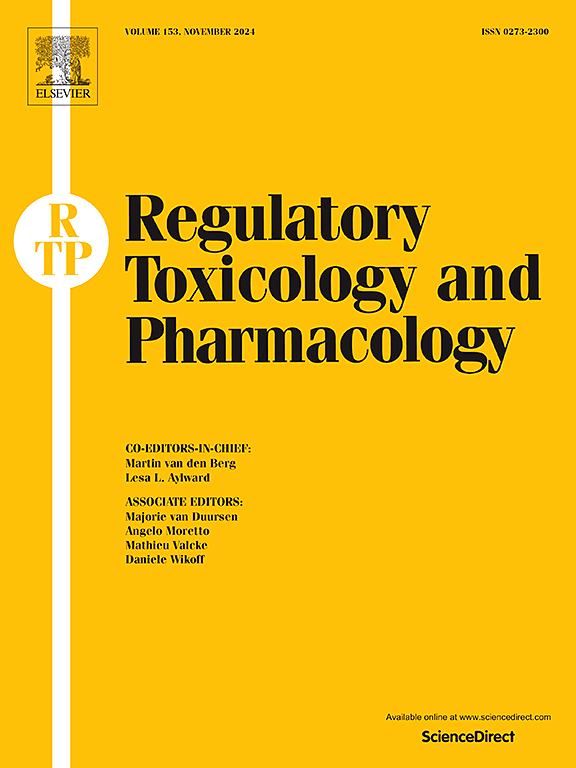十氢萘对Sprague Dawley大鼠生殖发育毒性筛选(OECD TG 421)和一代生殖毒性扩展研究(OECD TG 443)
IF 3.5
4区 医学
Q1 MEDICINE, LEGAL
引用次数: 0
摘要
采用OECD TG 421和TG 443对工业溶剂十氢萘(DHN)进行了生殖毒性研究。在TG 421中,口服剂量分别为0、100、300或1000 mg DHN/kg/天。在TG 443中,试验第30天将初始剂量0、30、100或300 mg/kg/天增加到0、60、200和600 mg/kg/天。高剂量TG 421雌性表现出发情周期中断;中、高剂量dam的植入量和产仔数较少。高剂量F0雌性TG 443表现出应激症状:体重下降,发情周期中断,肾上腺和胸腺重量增加,肾上腺皮质肥大和胸腺萎缩;在中等剂量时,这些影响不那么严重。高、中剂量TG 443 F0母鼠的产仔量和产仔数均较低,产仔重较低。TG 443的F1母犬的F2幼崽数量较少,产仔重量较低。DHN对生殖的影响表明卵巢功能受损。tg443的中、高剂量F0显示出明显的应激迹象,而卵巢对应激是敏感的。因此,DHN的影响被认为是继发于母亲压力,与人类无关。本文章由计算机程序翻译,如有差异,请以英文原文为准。

Reproductive and developmental toxicity screen (OECD TG 421) and extended one generation reproductive toxicity study (OECD TG 443) of decahydronaphthalene in Sprague Dawley rats
Decahydronaphthalene (DHN), an industrial solvent, was evaluated in OECD TG 421 and TG 443 reproductive toxicity studies in Sprague Dawley rats. In the TG 421, oral doses were 0, 100, 300, or 1000 mg DHN/kg/day. In the TG 443, initial doses of 0, 30, 100, or 300 mg/kg/day were increased to 0, 60, 200, and 600 mg/kg/day on test day 30. High dose TG 421 females exhibited estrous cycle disruption; mid and high dose dams had fewer implantations and pups/litter. High dose F0 females in the TG 443 showed signs of stress: lower body weight, disrupted estrous cycling, higher adrenal and lower thymus weights, adrenocortical hypertrophy and thymic atrophy; these effects were less severe at the mid dose. High and mid dose TG 443 F0 females also had fewer implantations and pups per litter and lower litter weight. F1 females in the TG 443 had nominally fewer F2 pups and lower litter weight. The reproductive effects of DHN indicate impaired ovarian function. Mid and high dose F0 dams in the TG 443 showed clear signs of stress, to which the ovary is known to be sensitive. Therefore, DHN's effects are considered secondary to maternal stress, and not relevant to humans.
求助全文
通过发布文献求助,成功后即可免费获取论文全文。
去求助
来源期刊
CiteScore
6.70
自引率
8.80%
发文量
147
审稿时长
58 days
期刊介绍:
Regulatory Toxicology and Pharmacology publishes peer reviewed articles that involve the generation, evaluation, and interpretation of experimental animal and human data that are of direct importance and relevance for regulatory authorities with respect to toxicological and pharmacological regulations in society. All peer-reviewed articles that are published should be devoted to improve the protection of human health and environment. Reviews and discussions are welcomed that address legal and/or regulatory decisions with respect to risk assessment and management of toxicological and pharmacological compounds on a scientific basis. It addresses an international readership of scientists, risk assessors and managers, and other professionals active in the field of human and environmental health.
Types of peer-reviewed articles published:
-Original research articles of relevance for regulatory aspects covering aspects including, but not limited to:
1.Factors influencing human sensitivity
2.Exposure science related to risk assessment
3.Alternative toxicological test methods
4.Frameworks for evaluation and integration of data in regulatory evaluations
5.Harmonization across regulatory agencies
6.Read-across methods and evaluations
-Contemporary Reviews on policy related Research issues
-Letters to the Editor
-Guest Editorials (by Invitation)

 求助内容:
求助内容: 应助结果提醒方式:
应助结果提醒方式:


